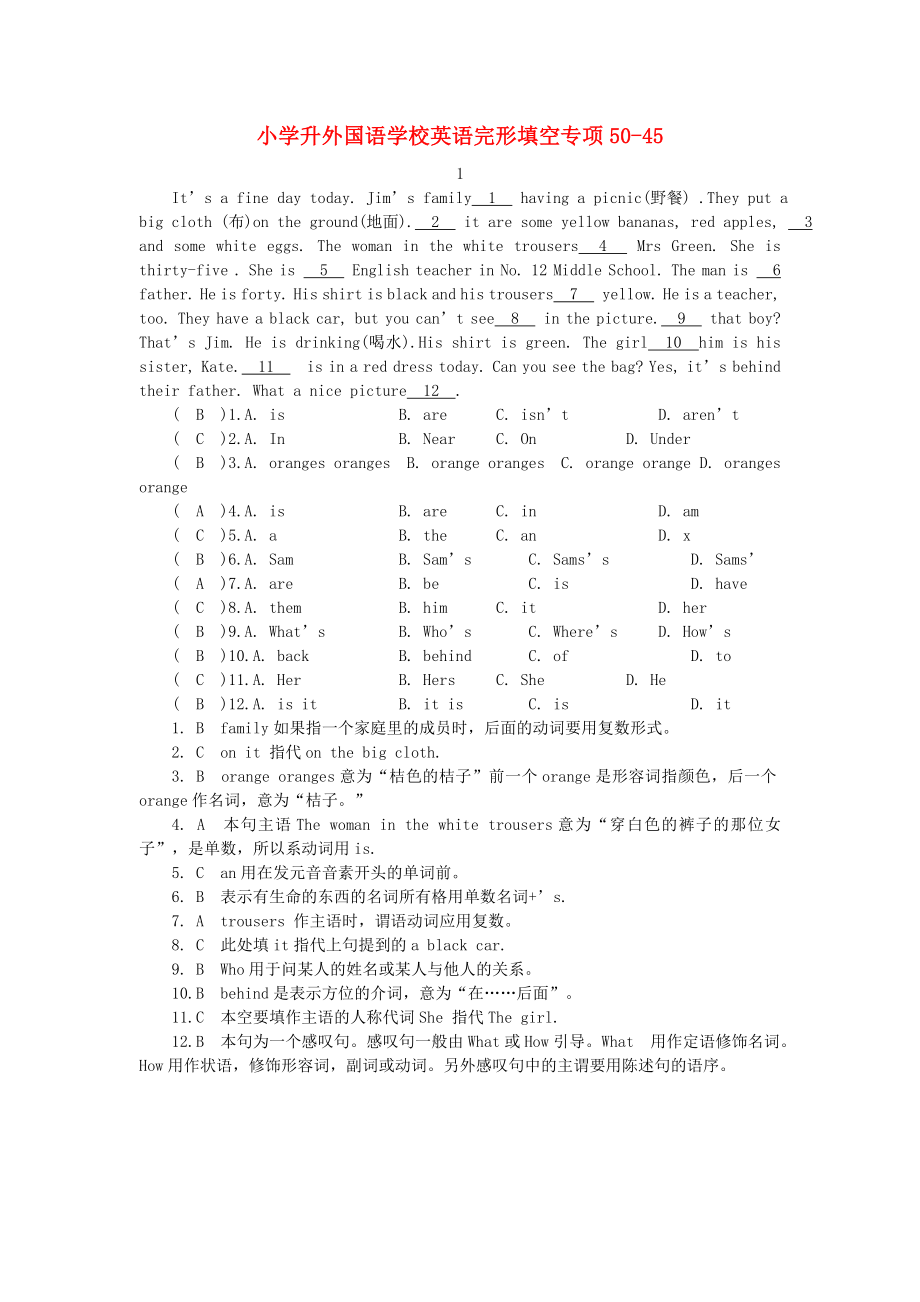《寧夏外國(guó)語(yǔ)學(xué)校小升初英語(yǔ)專項(xiàng)訓(xùn)練 完形填空45》由會(huì)員分享���,可在線閱讀�����,更多相關(guān)《寧夏外國(guó)語(yǔ)學(xué)校小升初英語(yǔ)專項(xiàng)訓(xùn)練 完形填空45(2頁(yè)珍藏版)》請(qǐng)?jiān)谘b配圖網(wǎng)上搜索�。
1���、小學(xué)升外國(guó)語(yǔ)學(xué)校英語(yǔ)完形填空專項(xiàng)50-45
1
It’s a fine day today. Jim’s family 1 having a picnic(野餐) .They put a big cloth (布)on the ground(地面). 2 it are some yellow bananas, red apples, 3 and some white eggs. The woman in the white trousers 4 Mrs Green. She is thirty-five . She is 5 English teacher
2�����、 in No. 12 Middle School. The man is 6 father. He is forty. His shirt is black and his trousers 7 yellow. He is a teacher, too. They have a black car, but you can’t see 8 in the picture. 9 that boy? That’s Jim. He is drinking(喝水).His shirt is green. The girl 10 him is his sister, Kate
3���、. 11 is in a red dress today. Can you see the bag? Yes, it’s behind their father. What a nice picture 12 .
( B )1.A. is B. are C. isn’t D. aren’t
( C )2.A. In B. Near C. On D. Under
( B )3.A. oranges oranges B. orange oranges C. orange orange D. oranges orange
( A )4.A
4、. is B. are C. in D. am
( C )5.A. a B. the C. an D. x
( B )6.A. Sam B. Sam’s C. Sams’s D. Sams’
( A )7.A. are B. be C. is D. have
( C )8.A. them B. him C. it D. her
( B )9.A. What’s B. Who’s C. Where’s D. How’s
( B )10.A. back B. behind C. o
5����、f D. to
( C )11.A. Her B. Hers C. She D. He
( B )12.A. is it B. it is C. is D. it
1. B family如果指一個(gè)家庭里的成員時(shí),后面的動(dòng)詞要用復(fù)數(shù)形式����。
2. C on it 指代on the big cloth.
3. B orange oranges意為“桔色的桔子”前一個(gè)orange是形容詞指顏色,后一個(gè)orange作名詞�����,意為“桔子?���!?
4. A 本句主語(yǔ)The woman in the white trousers意為“穿白色的褲子的那位女子”,
6����、是單數(shù)��,所以系動(dòng)詞用is.
5. C an用在發(fā)元音音素開(kāi)頭的單詞前�����。
6. B 表示有生命的東西的名詞所有格用單數(shù)名詞+’s.
7. A trousers 作主語(yǔ)時(shí)�����,謂語(yǔ)動(dòng)詞應(yīng)用復(fù)數(shù)����。
8. C 此處填it指代上句提到的a black car.
9. B Who用于問(wèn)某人的姓名或某人與他人的關(guān)系�。
10.B behind是表示方位的介詞��,意為“在……后面”�����。
11.C 本空要填作主語(yǔ)的人稱代詞She 指代The girl.
12.B 本句為一個(gè)感嘆句����。感嘆句一般由What或How引導(dǎo)。What 用作定語(yǔ)修飾名詞�。How用作狀語(yǔ),修飾形容詞�,副詞或動(dòng)詞。另外感
7����、嘆句中的主謂要用陳述句的語(yǔ)序。
2
Look 1 the picture. A boat is 2 the picture .Some persons(人) are in 3 boat. They are a man, a woman 4 two girls. Oh, a cat is in it, too. It’s Mimi. It’s 5 6 cat. The man is 7 a brown coat. The girls are 8 hats. The woman is 9 10
8��、.They are all very nice.
( A )1.A. at B. in C. after D. to
( B )2.A. on B. in C. at D. behind
( C )3.A. a B. an C. the D. /
( B )4.A. or B. and C. but D. too
( C )5.A. an B. the C. a D. /
( A )6.A. black B. your C. her D. their
( C )7.A. o
9����、n B. at C. in D. of
( A )8.A. in B. behind C. of D. at
( C )9.A. on B. at C. in D. to
( D )10.A. the red B. a red C. an red D. red
1. A at用在look后���,指“看……”,可接賓語(yǔ)���,look則不可以直接加賓語(yǔ)��。
2. B in the picture在圖畫(huà)里���,英語(yǔ)中,不用介詞on指圖畫(huà)上的東西��,而用in.
3. C 此處特指上句的A boat����。
4. B 英語(yǔ)中,and常用來(lái)連接相同屬性的人或事物����。
5. C 英語(yǔ)中,普通名詞以某種顏色做修飾語(yǔ)�����,常常在顏色修飾前加不定冠詞a或者an.
6. A 由下文看來(lái),應(yīng)用表示顏色的詞�����,其他物主代詞與前一題的冠詞不能同時(shí)應(yīng)用��。
7. C 本題中����,in可譯作“戴著,穿著”�。in a brown coat穿著褐色上衣�����。
8. A in hat戴著帽子���。
9. C 本題主要考查介詞“in+顏色”的習(xí)慣表達(dá)����?��!癷n+顏色”可譯作“穿…顏色的衣服”����,只指顏色,忽略是上衣還是褲子��。
10.D 本題主要考查用顏色來(lái)代替衣服��。本題red是形容詞��,其前不可以加冠詞�����。
 寧夏外國(guó)語(yǔ)學(xué)校小升初英語(yǔ)專項(xiàng)訓(xùn)練 完形填空45
寧夏外國(guó)語(yǔ)學(xué)校小升初英語(yǔ)專項(xiàng)訓(xùn)練 完形填空45

